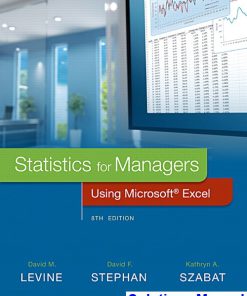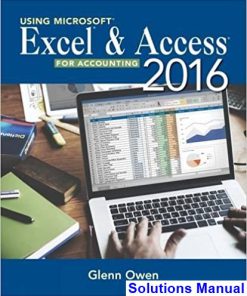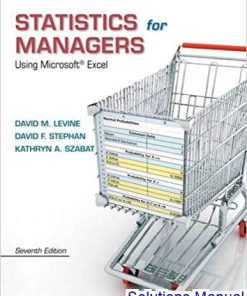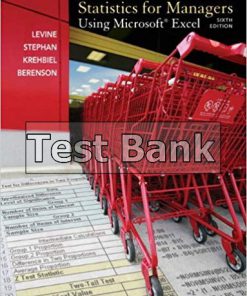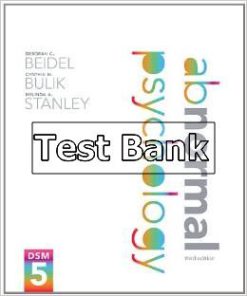Statistics for Managers Using Microsoft Excel 7th Edition Levine Test Bank
$26.50$50.00 (-47%)
Statistics for Managers Using Microsoft Excel 7th Edition Levine Test Bank.
You may also like
Instant download Statistics for Managers Using Microsoft Excel 7th Edition Levine Test Bank pdf docx epub after payment.

Product details:
- ISBN-10 : 0133061817
- ISBN-13 : 978-0133061819
- Author:
Intended primarily for undergraduate courses in business statistics, this text also provides practical content to current and aspiring industry professionals.
Reducing the emphasis on doing computations, this practical text thoroughly integrates Microsoft Excel as a tool for analysis and presents statistical concepts in the context of the functional areas of business.
Table of contents:
F. First Things First
- FTF.1 Think Differently About Statistics
- FTF.2 Business Analytics: The Changing Face of Statistics
- FTF.3 Starting Point for Learning Statistics
- FTF.4 Starting Point for Using Software
- FTF.5 Starting Point for Using Microsoft Excel
1. Defining and Collecting Data
- 1.1 Defining Variables
- 1.2 Collecting Data
- 1.3 Types of Sampling Methods
- 1.4 Data Cleaning
- 1.5 Other Data Preprocessing Tasks
- 1.6 Types of Survey Errors
2. Organizing and Visualizing Variables
- 2.1 Organizing Categorical Variables
- 2.2 Organizing Numerical Variables
- 2.3 Visualizing Categorical Variables
- 2.4 Visualizing Numerical Variables
- 2.5 Visualizing Two Numerical Variables
- 2.6 Organizing a Mix of Variables
- 2.7 Visualizing a Mix of Variables
- 2.8 Filtering and Querying Data
- 2.9 Pitfalls in Organizing and Visualizing Variables
3. Numerical Descriptive Measures
- 3.1 Measures of Central Tendency
- 3.2 Measures of Variation and Shape
- 3.3 Exploring Numerical Variables
- 3.4 Numerical Descriptive Measures for a Population
- 3.5 The Covariance and the Coefficient of Correlation
- 3.6 Descriptive Statistics: Pitfalls and Ethical Issues
4. Basic Probability
- 4.1 Basic Probability Concepts
- 4.2 Conditional Probability
- 4.3 Ethical Issues and Probability
- 4.4 Bayes’ Theorem
- 4.5 Counting Rules
5. Discrete Probability Distributions
- 5.1 The Probability Distribution for a Discrete Variable
- 5.2 Binomial Distribution
- 5.3 Poisson Distribution
- 5.4 Covariance of a Probability Distribution and Its Application in Finance
- 5.5 Hypergeometric Distribution
6. The Normal Distribution and Other Continuous Distributions
- 6.1 Continuous Probability Distributions
- 6.2 The Normal Distribution
- 6.3 Evaluating Normality
- 6.4 The Uniform Distribution
- 6.5 The Exponential Distribution
- 6.6 The Normal Approximation to the Binomial Distribution
7. Sampling Distributions
- 7.1 Sampling Distributions
- 7.2 Sampling Distribution of the Mean
- 7.3 Sampling Distribution of the Proportion
- 7.4 Sampling from Finite Populations
8. Confidence Interval Estimation
- 8.1 Confidence Interval Estimate for the Mean (σ Known)
- 8.2 Confidence Interval Estimate for the Mean (σ Unknown)
- 8.3 Confidence Interval Estimate for the Proportion
- 8.4 Determining Sample Size
- 8.5 Confidence Interval Estimation and Ethical Issues
- 8.6 Application of Confidence Interval Estimation in Auditing
- 8.7 Estimation and Sample Size Determination for Finite Populations
- 8.8 Bootstrapping
9. Fundamentals of Hypothesis Testing: One-Sample Tests
- 9.1 Fundamentals of Hypothesis Testing
- 9.2 t Test of Hypothesis for the Mean (σ Unknown)
- 9.3 One-Tail Tests
- 9.4 Z Test of Hypothesis for the Proportion
- 9.5 Potential Hypothesis-Testing Pitfalls and Ethical Issues
- 9.6 Power of the Test
10. Two-Sample Tests
- 10.1 Comparing the Means of Two Independent Populations
- 10.2 Comparing the Means of Two Related Populations
- 10.3 Comparing the Proportions of Two Independent Populations
- 10.4 F Test for the Ratio of Two Variances
- 10.5 Effect Size
11. Analysis of Variance
- 11.1 One-Way ANOVA
- 11.2 Two-Way ANOVA
- 11.3 The Randomized Block Design
- 11.4 Fixed Effects, Random Effects, and Mixed Effects Models
12. Chi-Square and Nonparametric Tests
- 12.1 Chi-Square Test for the Difference Between Two Proportions
- 12.2 Chi-Square Test for Differences Among More Than Two Proportions
- 12.3 Chi-Square Test of Independence
- 12.4 Wilcoxon Rank Sum Test for Two Independent Populations
- 12.5 Kruskal-Wallis Rank Test for the One-Way ANOVA
- 12.6 McNemar Test for the Difference Between Two Proportions (Related Samples)
- 12.7 Chi-Square Test for the Variance or Standard Deviation
- 12.8 Wilcoxon Signed Ranks Test for Two Related Populations
13. Simple Linear Regression
- 13.1 Simple Linear Regression Models
- 13.2 Determining the Simple Linear Regression Equation
- 13.3 Measures of Variation
- 13.4 Assumptions of Regression
- 13.5 Residual Analysis
- 13.6 Measuring Autocorrelation: The Durbin-Watson Statistic
- 13.7 Inferences About the Slope and Correlation Coefficient
- 13.8 Estimation of Mean Values and Prediction of Individual Values
- 13.9 Potential Pitfalls in Regression
14. Introduction to Multiple Regression
- 14.1 Developing a Multiple Regression Model
- 14.2 Evaluating Multiple Regression Models
- 14.3 Multiple Regression Residual Analysis
- 14.4 Inferences About the Population Regression Coefficients
- 14.5 Testing Portions of the Multiple Regression Model
- 14.6 Using Dummy Variables and Interaction Terms
- 14.7 Logistic Regression
- 14.8 Cross-Validation
15. Multiple Regression Model Building
- 15.1 The Quadratic Regression Model
- 15.2 Using Transformations in Regression Models
- 15.3 Collinearity
- 15.4 Model Building
- 15.5 Pitfalls in Multiple Regression and Ethical Issues
16. Time-Series Forecasting
- 16.1 Time-Series Component Factors
- 16.2 Smoothing an Annual Time Series
- 16.3 Least-Squares Trend Fitting and Forecasting
- 16.4 Autoregressive Modeling for Trend Fitting and Forecasting
- 16.5 Choosing an Appropriate Forecasting Model
- 16.6 Time-Series Forecasting of Seasonal Data
- 16.7 Index Numbers
17. Business Analytics
- 17.1 Business Analytics Overview
- 17.2 Descriptive Analytics
- 17.3 Decision Trees
- 17.4 Clustering
- 17.5 Association Analysis
- 17.6 Text Analytics
- 17.7 Prescriptive Analytics
18. Getting Ready to Analyze Data in the Future
- 18.1 Analyzing Numerical Variables
- 18.2 Analyzing Categorical Variables
19. Statistical Applications in Quality Management (online)
- 19.1 The Theory of Control Charts
- 19.2 Control Chart for the Proportion: The p Chart
- 19.3 The Red Bead Experiment: Understanding Process Variability
- 19.4 Control Chart for an Area of Opportunity: The c Chart
- 19.5 Control Charts for the Range and the Mean
- 19.6 Process Capability
- 19.7 Total Quality Management
- 19.8 Six Sigma
20. Decision Making
- 20.1 Payoff Tables and Decision Trees
- 20.2 Criteria for Decision Making
- 20.3 Decision Making with Sample Information
- 20.4 Utility
Appendices
People also search:
Statistics for Managers Using Microsoft Excel 7th Edition
Statistics for Managers Using Microsoft Excel 7th Edition pdf
Statistics for Managers Using Microsoft Excel
how to use excel for business statistics
microsoft excel for statistical analysis
|
business statistics excel formulas
|

